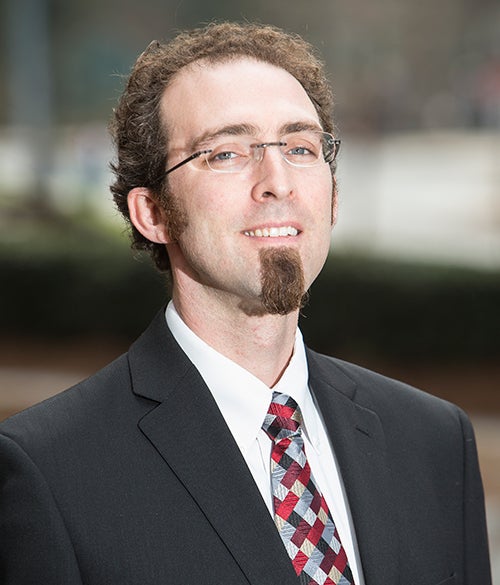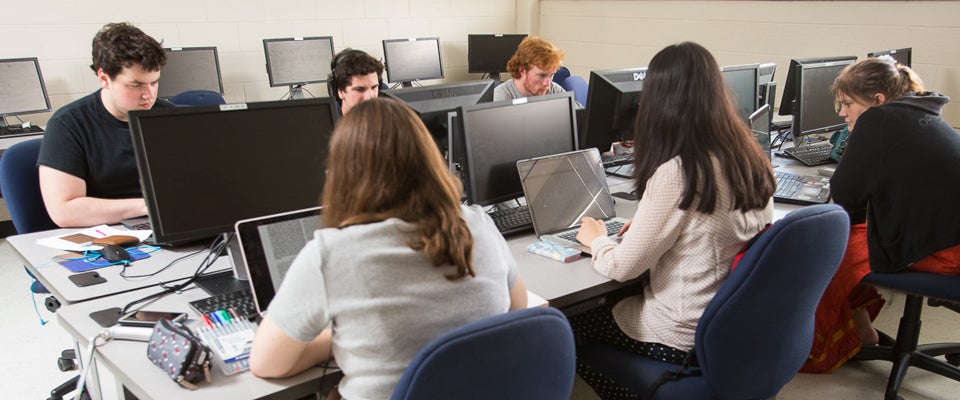DIGITAL SCHOLARSHIP
Students use technology to tell stories
Links to digital scholarship at ECU
- Thomas Herron, English: “Centering Spenser: A Digital Resource for Kilcolman Castle“
- Karin Zipf, history, and Margaret Bauer, English: the Wilmington Massacre of 1898
- Jennifer McKinnon, history, and collaborator: the Battle of Saipan
- Tom Allen, geography: N.C. Coastal Atlas
- Marylaura Papalas, foreign languages and literatures, and students: digital project for a French class; Greek literature class
- Derek Mahar, religious studies, and students: “Mapping the Buddhist Holy Land“
In the last century, scholars and students pored over dusty journals in libraries, often late into the night, to find those kernels of information that would push their own research forward.
Today, they are still working through the night, but it’s often with a laptop or tablet, pointing and clicking their way through not only online journals but also websites, maps and other sources that have linked vast stores of information in a sort of scholarly roadmap that leads to various, and sometimes unforeseen, destinations.
It’s called digital scholarship, and while it’s not replacing journal articles, it is presenting information in new, accessible ways.
“Digital scholarship is often very interdisciplinary,” said Derek Maher, a professor of philosophy and religious studies. “It can inform and create knowledge in new ways.” He’s leading a long-term digital project made possible by regular student-involved, summer study-abroad trips to India.
At ECU, Provost Ron Mitchelson, with the assistance of faculty and staff across disciplines, is working to improve the understanding and acceptance of this interdisciplinary, interactive form of research.
Toward that end, earlier this year, Mitchelson appointed Ben Fraser as chair of the new Digital Innovation in Social Sciences and Humanities Advisory Council.

Ben Fraser (Photo by Cliff Hollis)
“We are really still in the early stages of forging the infrastructure we’ll need to scale this up,” said Fraser, who also chairs the Department of Foreign Languages and Literatures in the Thomas Harriot College of Arts and Sciences. “But it is significant that the pathways to interdisciplinary collaboration are already there.”
The DISSH Advisory Council has members from the Thomas Harriot College of Arts and Sciences; College of Fine Arts and Communication; College of Engineering and Technology; Joyner Library; ECU’s Division of Research, Economic Development and Engagement; and the Office for Faculty Excellence.
An example of digital scholarship would be a website about a single topic that includes numerous additional components that link to new text, definitions, video, audio, maps and datelines. The person exploring the topic has the choice of where to travel within the information and generates his or her own experience moving through the subject.
Digital scholarship also takes advantage of geographic information systems technology. Information is presented in what is known as a story map. According to Maher, story mapping may be a less familiar concept, but it is still a very user-driven, interdisciplinary experience.
Examples of story mapping that use GIS technologies include the N.C. Coastal Atlas created by ECU geography faculty member Tom Allen.
“[Digital scholarship] ends up being a field of knowledge that you can move through, rather than being led through,” said Maher, who serves on the DISSH Advisory Council. “It is more interactive and tries to provoke the feel of the context, rather than getting a fixed narrative projected at you.”
Growth and funding
Although digital scholarship got started a couple of decades ago, it is now surging at ECU.
“Digital scholarship increases access to historical texts, works of literature and other works often found in hard-to-access archives and collections,” said Michael Van Scott, ECU’s interim vice chancellor for research, economic development and engagement. It also increases the analytical technologies and methodologies that can be used in studying those works and promotes communication among scholars focused on the same works, he added.
Jeffrey Johnson, professor of English, is also general editor of “The Variorum Edition of the Poetry of John Donne,” which includes a significant digital resource. Johnson’s research has been funded with approximately $1.8 million from the National Endowment for the Humanities during the past 25 years. He said digital scholarship is generally more accessible to the public compared to journal articles and much more interactive.
“Whenever we can make the works publicly available, the NEH is glad for that,” he said. “It is becoming more and more prevalent, and funding is becoming more and more prevalent.”
The best digital scholarship is peer-reviewed, like a journal article, he said. And the federal support he has received has allowed him to get students involved in the research and creation of the digital resources.
“There is no question they like getting their hands virtually dirty in online projects like this,” Johnson said.
Fraser said ECU can become a national leader in interdisciplinary digital research and teaching. “If we look at the challenges that eastern North Carolina is facing – and at the way awareness of global issues and technological expertise are becoming requirements for success in the workforce – strengthening the interdisciplinary ties that bind our students, our university and our region can have a real impact,” he said.
According to Fraser, ECU has done two important things so far pertaining to digital scholarship: defining digital scholarship more widely, not just as digital humanities, but as “digital social sciences and humanities,” to recognize the way perspectives from human, social and cultural geography and GIS technology have increased in digital humanities over the past two decades; and beginning an annual DISSH symposium. The next one is tentatively scheduled for March.
“The event has really showcased the potential for university-wide synergies here at ECU,” said Fraser.
This fall, Mitchelson has tasked the DISSH Advisory Council with building support among constituents on the ECU campus. He’s also made a budget request to keep the momentum going.
“(Digital scholarship) has the tremendous benefit of knitting disciplines together in effective collaborations,” Mitchelson said. “I like that part the best.”
“If we strengthen the collaborative ties between departments and colleges participating in these initiatives, and if we develop a hub that organizes our collective efforts, centralizes our resources and begins to take advantage of potential synergies between diverse projects, there are no limits,” said Fraser.
In addition, as external grant funding for ECU digital projects continues to grow, Fraser said ECU will be more competitive for larger institutional grants, continuing to propel ECU forward in the discipline of digital scholarship.
As the council moves forward, it wants to increase the opportunities for graduate and undergraduate students from different disciplines to work together on faculty and/or community-led projects.
“We’re looking for anyone who wants to get involved, not just in the humanities and social sciences, but in art/animation, engineering and computer science,” said Fraser.
For more information about digital scholarship or ways to get involved, contact Fraser at 252-328-0104 or via email at fraserb14@ecu.edu. Information about ECU’s DISSH Lab is online at www.ecu.edu/cs-cas/DISSHLAB. Housed in Brewster D-212, it includes a 3D printer, computers, software and hardware for creating digital projects.

Although digital scholarship got started a couple of decades ago, it is now surging at ECU. (Photo by Cliff Hollis)